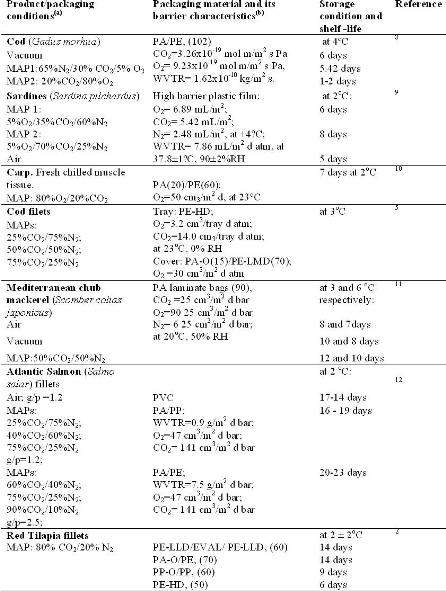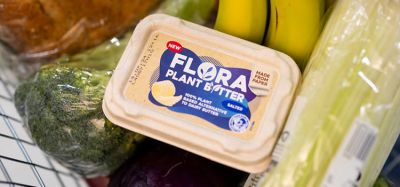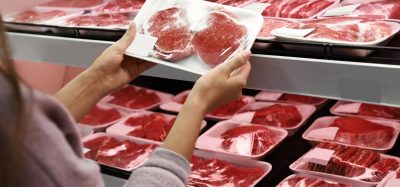Plastic packaging for fish and seafood
- Like
- Digg
- Del
- Tumblr
- VKontakte
- Buffer
- Love This
- Odnoklassniki
- Meneame
- Blogger
- Amazon
- Yahoo Mail
- Gmail
- AOL
- Newsvine
- HackerNews
- Evernote
- MySpace
- Mail.ru
- Viadeo
- Line
- Comments
- Yummly
- SMS
- Viber
- Telegram
- Subscribe
- Skype
- Facebook Messenger
- Kakao
- LiveJournal
- Yammer
- Edgar
- Fintel
- Mix
- Instapaper
- Copy Link
Posted: 6 November 2012 | Kata Galić, Faculty of Food Technology and Biotechnology, University of Zagreb | No comments yet
In the past few decades, there has been a significant increase in the amount of plastics being used in food packaging applications. This is because plastics bring in enormous advantages, such as thermosealability, flexibility in thermal and mechanical properties, permit integrated processes (i.e. plastic packages can be formed, filled and sealed in a continuous manner within the production line), lightness and low price. However, polymers do also have a number of limitations for certain applications when compared with more traditional materials like metals and glass.
The chief limitation is their inherent permeability to the transport of low molecular weight components which leads to issues such as food oxidation by penetration of oxygen, migration of elements from the plastic and scalping of food components on the packaging, with consequent losses in food quality and safety attributes. Among these, the potential migration beyond the legal limits of polymer constituents and additives is perhaps the most widely recognised issue regarding packaged food safety. In spite of this, plastic materials continue to expand and replace the conventional use of tinplated steel cans and glass. Initially, most plastic packaging was made of monolayer semi-rigid or flexible materials but, as the advantages of plastic packaging became more established and developed, the increasingly demanding food product requirements led, in conjunction with significant advances in plastic processing technologies, to more and more complex polymeric packaging formulations.
In the past few decades, there has been a significant increase in the amount of plastics being used in food packaging applications. This is because plastics bring in enormous advantages, such as thermosealability, flexibility in thermal and mechanical properties, permit integrated processes (i.e. plastic packages can be formed, filled and sealed in a continuous manner within the production line), lightness and low price. However, polymers do also have a number of limitations for certain applications when compared with more traditional materials like metals and glass. The chief limitation is their inherent permeability to the transport of low molecular weight components which leads to issues such as food oxidation by penetration of oxygen, migration of elements from the plastic and scalping of food components on the packaging, with consequent losses in food quality and safety attributes. Among these, the potential migration beyond the legal limits of polymer constituents and additives is perhaps the most widely recognised issue regarding packaged food safety. In spite of this, plastic materials continue to expand and replace the conventional use of tinplated steel cans and glass. Initially, most plastic packaging was made of monolayer semi-rigid or flexible materials but, as the advantages of plastic packaging became more established and developed, the increasingly demanding food product requirements led, in conjunction with significant advances in plastic processing technologies, to more and more complex polymeric packaging formulations.
In the past few decades, there has been a significant increase in the amount of plastics being used in food packaging applications. This is because plastics bring in enormous advantages, such as thermosealability, flexibility in thermal and mechanical properties, permit integrated processes (i.e. plastic packages can be formed, filled and sealed in a continuous manner within the production line), lightness and low price. However, polymers do also have a number of limitations for certain applications when compared with more traditional materials like metals and glass.
The chief limitation is their inherent permeability to the transport of low molecular weight components which leads to issues such as food oxidation by penetration of oxygen, migration of elements from the plastic and scalping of food components on the packaging, with consequent losses in food quality and safety attributes. Among these, the potential migration beyond the legal limits of polymer constituents and additives is perhaps the most widely recognised issue regarding packaged food safety. In spite of this, plastic materials continue to expand and replace the conventional use of tinplated steel cans and glass. Initially, most plastic packaging was made of monolayer semi-rigid or flexible materials but, as the advantages of plastic packaging became more established and developed, the increasingly demanding food product requirements led, in conjunction with significant advances in plastic processing technologies, to more and more complex polymeric packaging formulations. This resulted in complex multicomponent structures such as the so-called multi-layer packaging-based systems widely used today, which in many cases can make use of metallised layers.
In order to meet the huge demand of the food industry, there has been a remarkable growth in the development of food packaging in the past few decades.
Barrier packaging requirements
The choice of fish packaging is no longer simple. To date, a range of different packaging materials and packaging technologies have been developed to facilitate quality improvement and preservation of packaged foods. Most of the materials are new with improving functions through lamination, coating or incorporating active materials.
Polymer blends are often developed to take advantage of the synergism of two or more distinct polymer components. The number of layers in a multilayer structure range from three to 13 but most commercial multilayer packaging materials include three, five and seven layer structures1.
The key consideration for the food packaging is the level of barrier required. A product often needs to be protected from oxygen, moisture vapour or light.
Gas barrier
Modified atmosphere packaging (MAP) for fish requires a high barrier to carbon dioxide (CO2), oxygen (O2) and nitrogen (N2). The pre-determined gas mixture has to stay inside the package and remain the same. Therefore, packaging films or layers with a high gas barrier are applied. Packaging materials used for MAP are a combination of different substrates. The materials can be as simple as two-ply laminations or as sophisticated as multi-layer co-extrusions, incorporating ethylene/vinyl alcohol (EVAL) as a high barrier substrate2. As a coating, polyvinyl alcohol (PVAL) also provides excellent oxygen and aroma barrier properties. However, these properties are dependent on humidity; in other words, with higher humidity more water is absorbed. The water, which acts as a plasticiser, will then reduce its tensile strength, but increase its elongation and tear strength. PVAL is fully degradable and dissolves quickly3.
Water vapour barrier
Impermeability to water vapour is important for fish packages as its quality is adversely altered by dehydration. Several plastics having good water vapour barriers like PVDC, coated oriented polypropylene (PP-O) and high density polyethylene (PE-HD) are used. Other plastics like polyamides (PA) and polystyrene (PS) have a poor water vapour barrier and yet some other plastics like EVAL can be adversely affected by moisture. Hence, in most packaging applications, the films must be laminated on both sides to protect it from contact with moisture.
Heat sealability
A tight seal has to be formed between the tray and lidding material to prevent contamination and dehydration of fish. Since the fish packages are sold in supermarkets along with other food products, the strong fish odour should not be allowed to spread. Low density polyethylene (PE-LD), ethylene/vinyl acetate (EVAC) and polypropylene (PP) are widely used as a heat seal layer in laminates of fresh fish packaging.
Mechanical damage
Fresh fish can be easily bruised. An expanded polystyrene (PS-E) tray is widely used to protect the sensitive product. To provide gas barrier and heat seal properties, PS-E is used in combination with EVAL and PE-LD to provide a suitable package. At times, a rigid PE-HD tray is also used. A sufficient head-space with puncture resistant films like polyamides completes the package.
Oil Resistance
For fatty fish, oil resistant films like PA, PVDC and unplasticised poly(vinyl chloride), PVC-U, may be considered. Poly(ethylene terephthalate), PET, and PP-O are also used as they provide an excellent oil barrier. PVAL is resistant to oil, grease and solvent. It is odourless and nontoxic.
Transparency
For fresh food, the visibility of the product is important to the consumer. PET and PP films have superior optical clarity and, therefore, are applied for fish packaging over-wraps and as lidding materials. The polymers may also be blended with antifogging agents in order to reduce condensation on the lidding film.
Drip absorber
Fresh fish packaged under modified atmos – phere conditions may drip. In order to reduce bacterial growth and provide a clean package interior, absorbent pads are enclosed. Pads made of cellulose are placed under the fish or when an PS-E tray is used, are integrated as a layer.
Insulation
Insulation is of particular importance in transport packaging of ice chilled fish. Expanded polystyrene trays and boxes are generally used as retail and transport packages respectively.
Vacuum and Modified Atmosphere Packaging (MAP)
Laminated materials are used to give a longer shelf life. Thus, there is a wide range of package types available for specific food range (frozen, vacuum, MAP etc.). However, the choice of package types has to be made carefully, bearing in mind the nature of the product, storage performance and cost.
A pigment commonly added to the film protects the frozen food contents from light that can initiate and catalyse oxidation. Coating the PE-LD or PE-HD with PET or PVDC/PVC copolymer gives the product additional protection from oxygen. Alternatively, sandwiching moisture-sensitive EVAL copolymer or PA between layers of PE provides oxygen-barrier protection. Pouches can also be made with bottom gussets and zipper resealing features, which allow them to be ‘stand-up pouches’ with more visibility for marketing and greater convenience for consumers.
Typical vacuum packaging materials consist of laminates such as: PP-O / EVAL / PE; PA/PE; PET/PE; PP-O / PVDC / PE; PP-O / PVDC / PP-O, PVC / EVAL / PVC with oxygen transmission rate (OTR) less than 15 cm3/m2 day atm.
Some of the traditional polymers are now replaced with new materials. For instance, PVC is being replaced by amorphous PET (PET-A) or PS/EVAL while PVDC is being replaced by EVAL or PA-O.
The packages for modified atmosphere products are usually high barrier laminates, sealed onto rigid trays. Most packaging is performed on thermoform / fill / seal machines using PVC-PVDC / PE-LD or PET / PVDC / PE-LD lidding materials.
For the thermoformed base trays laminates, such as PS/EVAL/PE; PET/EVAL/PE, are used. The use of modified atmosphere packaging (MAP) generally results in an increased sensory shelf life when compared with traditional ice storage, but the magnitude of the increase depends on various factors such as the compo – sition of the gas mixture, storage temperature, raw material quality and pack size. Lower levels of CO2 are generally used to reduce water loss and textural defects. The use of N2 to replace O2 or vacuum packaging does not lead to as much freshness extension in marine fresh fish products. Vacuum packaging of marine fish products was not found to be a better alternative to MAP4.
The effectiveness of MAP is generally determined by the amount of available CO2 that can dissolve into food5.
The presence of CO2 is necessary to inhibit growth of common aerobic bacteria. At levels above 20 per cent in sufficiently large package volumes, growth is primarily inhibited in fish because CO2 lowers the pH level of the tissue surface. The CO2 concentration is normally 50 per cent in practical situations. Depending on the storage temperature (0–2°C), MAP prolongs the shelf-life by three to five days compared with the shelf life of raw fish in a tray with film overwrap. Excessively high concentrations can produce undesirable aftereffects in the form of lost tissue liquid or, in the case of crabs, an acidic or sour taste.
Oxygen can be used as a component of a modified atmosphere to avoid colour changes and pigment fading in fish and seafood. The gas is also used to prevent growth of anaerobic microorganisms such as Clostridium, which can produce toxins.
It has been shown that while CO2 decreased C. botulinum growth at chill temperatures, prevention of growth also depended on the NaCl concentration and the pH of the medium6. To combat rancidity, oxygen should not be used in packaging of high-fat fish. Oxygen attacks unsaturated fatty acids giving hydro peroxides which degrade into off-flavour compounds7. The shelf-life of fish products in MAP can be extended depending on raw material, temperature, gas mixtures and packaging materials (Table 1).
References
1. Goulas A.E., Riganakos K.A., Kontominas M.G. (2003) Effect of ionizing radiation on physicochemical and mechanical properties of commercial multilayer coextruded flexible plastics packaging materials, Radiation Physics and Chemistry 68 (5) 865–872
2. Siah, W. M., Mohd Tahir, S. (2011) Effect of different packaging materials on the shelf life of modified atmosphere packaged red tilapia (Oreochromis mossambica) fillets, International Food Research Journal, 18 (3) 1091-1095
3. Müller-Plathe, F. (1998) Diffusion of water in swollen poly(vinyl alcohol) membranes studied by molecular dynamics simulation. Journal of Membrane Science, 141 (2) 147-154
4. Lauzon H.L., B. Margeirsson, K. Sveinsdóttir, M. Guðjónsdóttir, M.G. Karlsdóttir, E. Martinsdóttir (2010) Overview on fish quality research. Impact of fish handling, processing, storage and logistics on fish quality deterioration, Skýrsla Matís, 39-10
5. Rotabakk B.T., Lekang O.I., Sivertsvik M. (2007) Volumetric method to determine carbon dioxide solubility and absorption rate in foods packaged in flexible or semi rigid package, Journal of Food Engineering, 82 (1) 43–50
6. Gibson, A. M., Ellis-Brownlee R.-C.L., Cahill M.E., Szabo E.A., Fletcher G.C., Bremier P.J. (2000) The effect of 100% CO2 and the growth of non-proteolytic C. botulinum at chill temperatures. International Journal of Food Microbiology, 54 (1) 39-48
7. Boran G., Karacam H., Boran M. (2006) Changes in the quality of fish oils due to storage temperature and time. Food Chemistry, 98 (4) 693-698
8. Corbo M. R., Altieri C., Bevilacqua A., Campaniello D., D’Amato D., Sinigaglia M., (2005) Estimating packaging atmosphere–temperature effects on the shelf life of cod fillets, European Food Research and Technology, 220 (5-6), 509–513
9. Erkan N., Özden Ö., Alakavuk D.Ü., Yildirim S.Y., Inuğur M. (2006) Spoilage and shelf life of sardines (Sardina pilchardus) packed in modified atmosphere, European Food Research and Technology, 222 (5-6) 667–673
10. Ježek F., Buchtová H. (2007) Physical and Chemical Changes in Fresh Chilled Muscle Tissue of Common Carp (Cyprinus carpio L.) Packed in a Modified Atmosphere, Acta Veterinaria Brno, 76 (8) S83–S93
11. Stamatis N., Arkoudelos J. (2007) Quality assessment of Scomber colias japonicus under modified atmosphere and vacuum packaging, Food Control 18 (4) 292–300
12. Fernández K., Aspé E., Roeckel M. (2010) Scaling up parameters for shelf-life extension of Atlantic Salmon (Salmo salar) fillets using superchilling and modified atmosphere packaging, Food Control, 21 (6) 857–862
About the author
Dr. Kata Galić is a Professor at the University of Zagreb, Faculty of Food Technology and Biotechnology. She graduated in 1982, received her MSc in 1985 and PhD in 1989, from the University of Zagreb, Faculty of Food Technology and Biotechnology. She received The British Council Fellowship, from 1990 to 1991, and J.W.T. Jones Fellowship in 1994. Her research interests include permeability characteristics of polymeric materials and factors affecting barrier changes of polymers used for food packaging. Her scientific (71) and professional (23) papers are published in international and national journals and presented at numbers of national and international meetings (66). Her teaching experience includes undergraduate and graduate lectures as well as supervision of diploma (32), master (4) and doctoral (2) theses.
She is a member of Editorial Board of the Trade Journal for Packaging, as well as member of Scientific Council at the Institute for packaging and material handling in Croatia. She was a vice-dean for the international scientific cooperation (2001-2003). She is the member of the executive committee of the European Federation of Food Science and Technology (EFFoST), Croatian Society of food technologists, biotechnologists and nutritionists (CROFoST), and marketing task force member of the International Union of Food Science and Technology (IUFoST). She is also the member of the Royal Society of Chemistry (UK). She received State award for scientific promotion in the area of biotechnical sciences in 2009.








